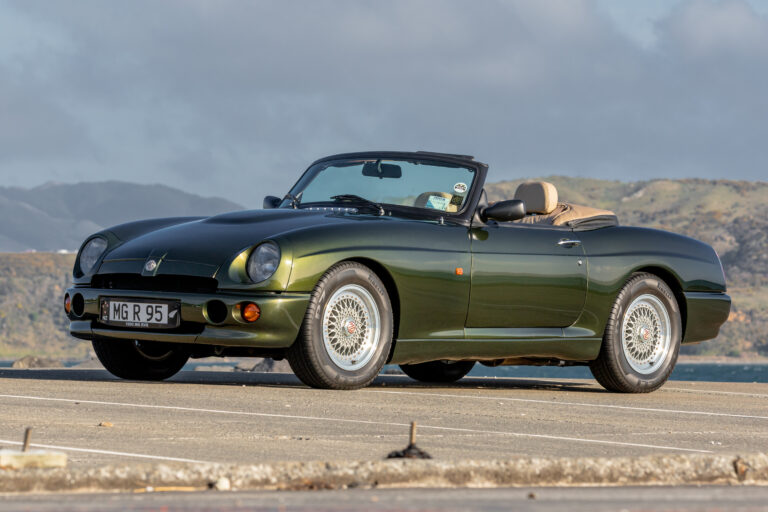Brendan Mason campaigned one of this country’s best-known muscle cars for 12 years. He has handed on the Big Red flame but now plans to meet it again on the track
By Quinton Taylor
Photography: Quinton Taylor, Dave Loudon Photography and archives
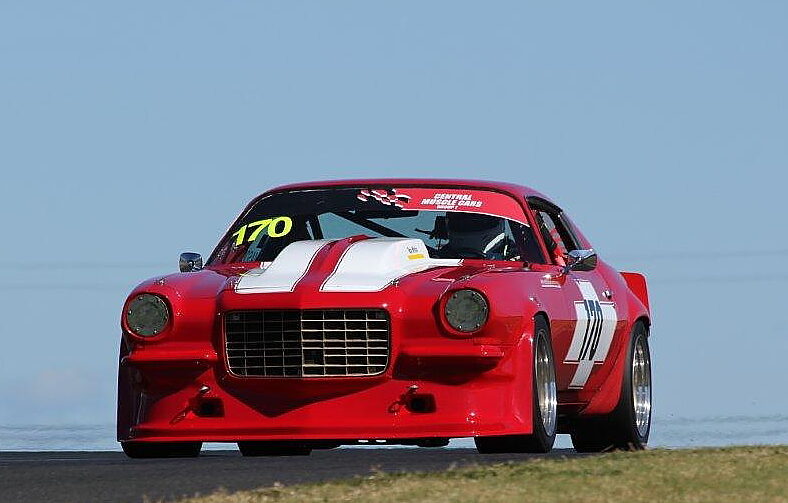
For more than a decade, Invercargill racing driver and businessman Brendan Mason has turned out for motor race meetings a lot less often than he would have liked with the 1970 Chevrolet Camaro known as ‘Big Red’.
“In total I have only done 37 race meetings in 12 years, which isn’t a lot due to the logistics and costs, but I have thoroughly enjoyed every minute I’ve worked and raced the car, and the friends I have made during the journey will be everlasting.”
Brendan had recently decided to quit motor racing and said those words soon after selling Big Red to Rob Lewis.
He says it’s been an entertaining 12 years with the ex–Wayne Anderson Pinepac Racing Camaro; it’s also been a rewarding one, with forays over the ditch to Eastern Creek [now Sydney Motorsport Park] in 2012 with the Central Muscle Cars (CMC) and again in 2016, on a CMC expedition to Bathurst.
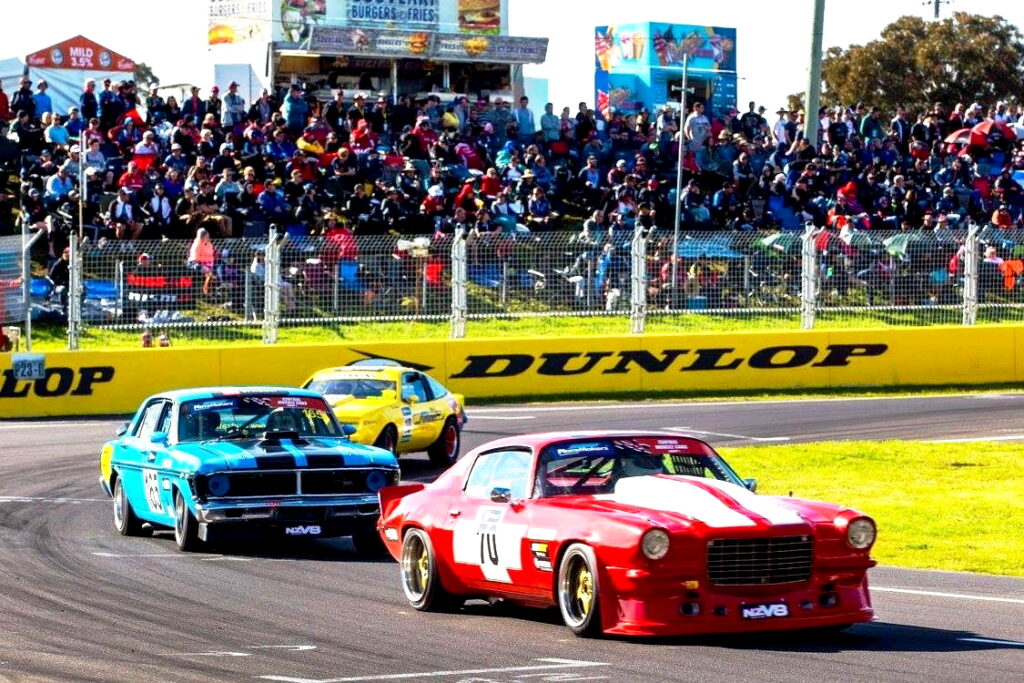

Bathurst first
“Bathurst has to be the pinnacle of race tracks to race on,” Brendan reckons.
“Bathurst most definitely was the most memorable. Second would be Eastern Creek. The car has been to Australia twice and that was the highlight. Bathurst is probably the best track in the Southern Hemisphere. Angus Fogg showed the Touring Car Masters invitation team from New Zealand how to drive it. “A bloody good driver,” is Brendan’s verdict.
In February 2018, during the Evolution Motorsport Classic race meeting at Teretonga Park Raceway, Brendan pulled off one of his best drives on the last day of the meeting, coming home a close second to Todd Stewart in the PDL Mustang. It was a nose-to-tail battle that might never have happened, but the PDL Mustang team put in a huge effort rectifying a fault that had sidelined their car in a previous race.
On the wind-down lap of the last race of the day for Classic Saloons over 2501cc, flag marshals left their safety posts to applaud the pair as they cruised past. Brendan had tried everything he could in a really close-fought race, waiting for Stewart to make a mistake.
“That was a pretty good one, wasn’t it?”
Brendan bought Big Red in late 2006 and it was some time before he could get it accepted for CMC.
“I raced in the classic series in the South Island for the first two years while I was trying to get accepted into Central Muscle Cars.The car was technically illegal with its aluminium 540ci big block, but the club decided to accept it under their grandfather clause,” Brendan explained.


Our man in Tauranga
Brendan remembers the second trip to Australia for its aftermath as much as the racing.
“I will never forget the time all 24 cars arrived back from Bathurst into the Port of Tauranga, and everyone was on alert for when the cars were ready to unload and pick up. I’d flown into Auckland and driven down the day before we were scheduled to unload.”
On their arrival, they were told there was a big hold-up, and everybody was told not to go to the port as customs and the paperwork was nowhere near ready.
Already in Tauranga, Brendan and a friend had nothing to do but wait. Then the port authorities got hold of CMC officials and said their staff would unload the cars and drive them into the MAF inspection building to be checked and cleaned if necessary, which put the cat among the pigeons.
As most owners were hours away, the organizing committee put in an SOS call to Brendan, asking if he could go to the port and oversee the unloading.
“We arrived just before the wharfies were about to start up and shift out the first racecar. Thank god we intervened. Race engines need special care on start-up, and they can be damaged very easily.”
One disaster avoided, but as they pushed the first car onto the hoist the MAF inspector arrived. He wasn’t in a great mood.
“When I realised he was trying to find any little bit of dirt on the underneath of the cars, which would earn MAF a $250 cleaning fee, I intervened. He let me get a vacuum cleaner, and I started ‘luxing’ under and inside the cars. I’m sure the dirt inside the cars was probably already New Zealand dirt.”
After pushing and cleaning 24 cars, they were worn out but celebrated the fact no cars had needed a MAF cleaning.
“The worst was Paul Clarke’s Mustang that had half of Conrod Straight’s grass under the car due to a blown radiator hose and Paul being courteous, not leaking fluid on the track. I can’t imagine the damage that could have been done if we weren’t there, but all in all it went smoothly.”
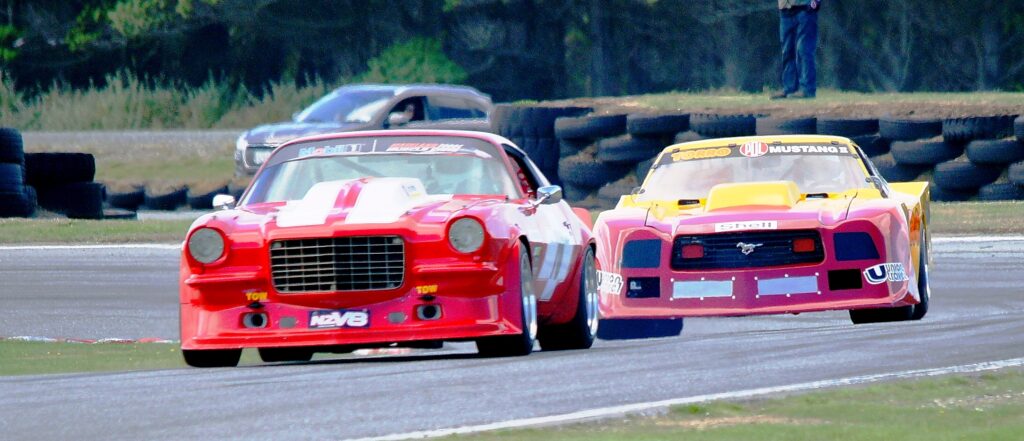
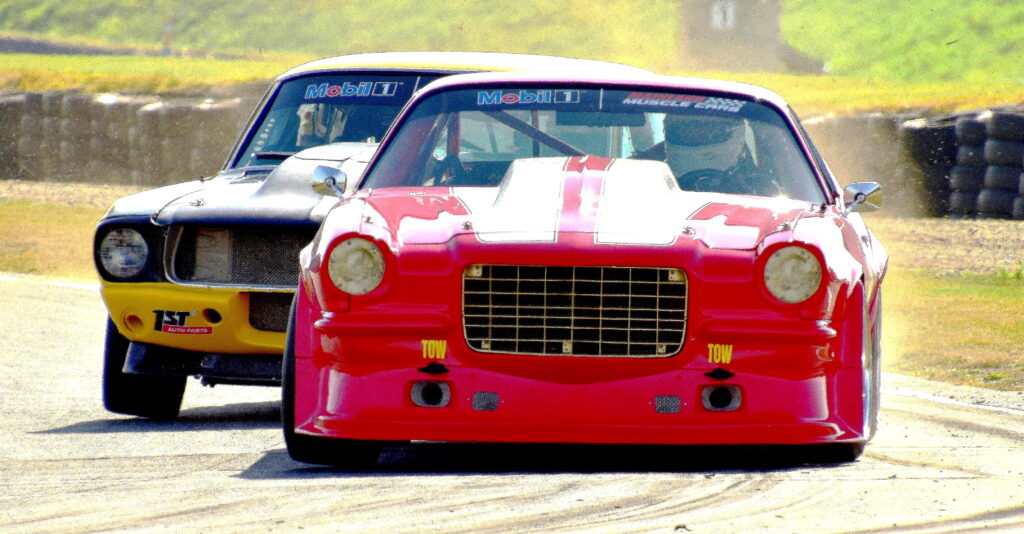
Big Red gets better
Big Red has only endured one excursion off the track in Brendon’s hands.
“I think it was back around 2012, when I went off the track at Teretonga. The damage bill came to around $10,000. But that’s motor racing and if you are too precious with your car then motor racing isn’t for you.”
Over the years, Big Red has undergone some changes from the car that Wayne Anderson drove.
“In 2015, I went away from the big-block engine as it was eating gearboxes and axles for breakfast due to over 700ft/lb of torque. I went to the small-block, Nascar-style engine. They were great bang for your buck and weighed a lot less. I had to change the diff ratio from 3.0: 1 to 3:73 to 1, as the Nascar engines make their horsepower between 6000–8000 revs.
Brakes, the original bugbear of the car’s performance, had also come in for attention.
“We changed the fronts to Nascar AP discs and Brembo callipers, and it now brakes very well. It totally changed the car.”
Brendan has clocked up over two decades of track work in a variety of cars, with a short break for a couple of years.
“John Abbott, whom I used to work for at Motoring Centre [Invercargill], decided to build me a race car. He found a 1970 Camaro and turned it into a classic racer. In 1994, I started classic car racing until 2000 with that car. I then sold that car to Ross Maxwell who made it into a Central Muscle Car and painted it yellow. I ended up racing against him.”
His next car was purchased from John Beck after a big crash.
“It was an Oscar RX7 — space-framed. It was brand new and did one lap when it crashed, so I bought it and did it up. I raced it for three or four years and then sold it to the late Colin Dawson. There was a bit of a gap for a couple of years racing, and I then bought the Camaro in late 2006.”
Also big thanks go to Bruce, Stockie (crew), Bruce Colyer Auto Refinisher, Phil Withington of USA KIWI Ltd (engine builder), and my wife Karen for supporting me through these years of racing.”

Keith Dorton, engine builder
Keith Dorton built his first hot-rod, a 1932 Ford powered by a flathead V8, when he was just 12 years old.
“In those days, especially in drag racing, nobody asked if you were under 16. I started racing there at 15 because I could get away with it.”
Racing and building race engines was in his blood — and what better start could he get for his first real job but working in the engine shop of Holman-Moody.
In 1965, he opened his own workshop, Automotive Workshops Racing Engines, specializing in race engines for all forms of motor sport in Concord, North Carolina. One of his first customers was Ralph Earnhardt, beginning a long association of three generations with the family. When Dale Jr formed JR Motorsports Team, Keith was asked to build all the race engines. He soon developed a reputation for building reliable race-winning engines.
Now in his mid-70s, Keith has struggled through a lifelong battle with multiple sclerosis and is a huge supporter and the public face of MS fund-raising charities. Along with the three generations of the Earnhardt family, his client list includes Nascar notables such as Junior Johnson, Bobby Allison, Carl Yarborough, and Smokey Yunick, bringing him a host of Engine Builder of the Year awards. He has also built engines for land-speed records at Bonneville Salt Flats, and in the first two years of being involved, his engines broke three records at the Flats.

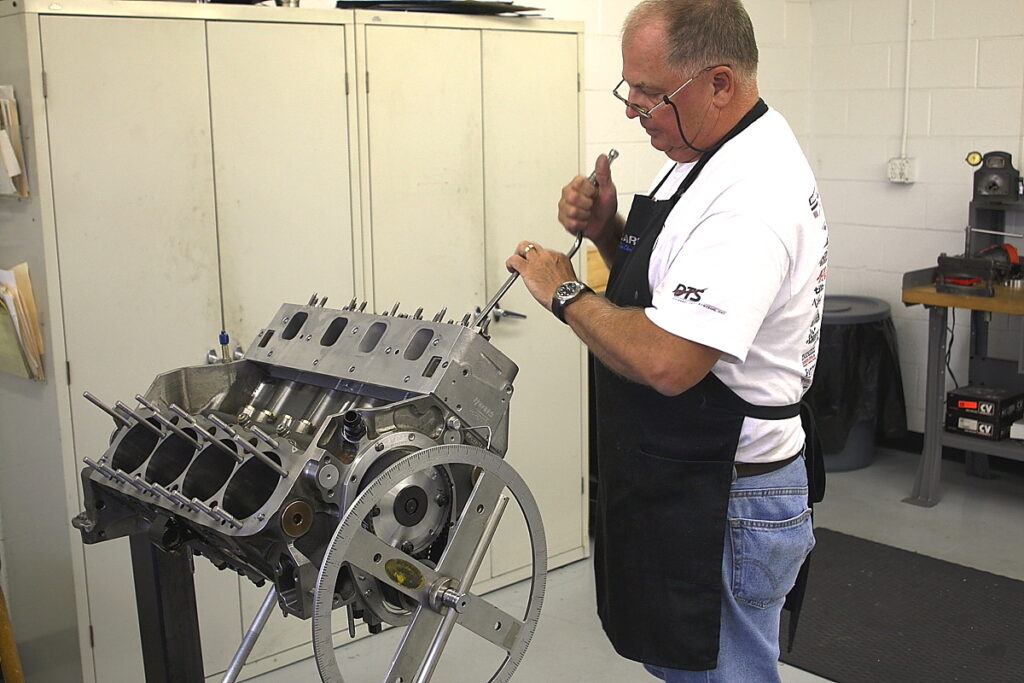
Retirement — sort of
Retiring from racing is one thing but staying retired is another. Brendan tried, selling Big Red to Rob Lewis a few weeks ago. A long-time NZV8 competitor and Ford Mustang campaigner, Rob intends to compete with it in the CMC races.
Brendan stayed involved, managing race meetings, and it looked for a time like his retirement from driving was sticking — but it didn’t. A carrot was dangled and Brendan snapped it up.
“Hmm. Yes that didn’t last long, did it? I’ve gone and bought the ex-Grant Dalton Camaro. It’s a 1970 Camaro, but it has all the latest gear such as brakes and suspension and it’s a fantastic car. It comes with a similar Nascar motor to the one I had in Big Red. So, back into it again, and I’m really looking forward to driving it.”
The Dalton Camaro was first built in 2011, then it was re-built again in 2016, Brendan explained.
“When I say rebuilt, it was totally changed — stripped right back and sand-blasted, and they reconfigured all the front suspension. They also reconfigured the rear end and made a lot of changes to when it was first built in 2011 by Ken Hopper of Hopper Car Construction.”
Ken Hopper was also responsible for building Big Red for Wayne Anderson. And the new car went back into the fold for the rebuild.
“In 2016, they employed Wayne Anderson, who used to own Big Red. Wayne owns a business called AV8 Motorsport. Wayne completely reconfigured the car and changed it all and made it go a lot faster. They spent $40,000 just on the front suspension at AV8.”
Legendary engine builder Keith Dorton, owner of Automotive Specialists Racing Engines of Concord, North Carolina, also added to the mix.
“They got a new engine from the States. It was completely hand-built in the States. The engine that came with the car was the latest engine that he [Dorton] built and cost over NZ$100,000. All brand new, it dynoed at 910hp [679kW]. It really is a weapon of an engine. I’ve got the dyno results of before it went to Bathurst. They put the car on the dyno in Auckland before it went to Bathurst, and it was 804hp [599.5kW] at the rear wheels. It’s definitely a proven engine.”
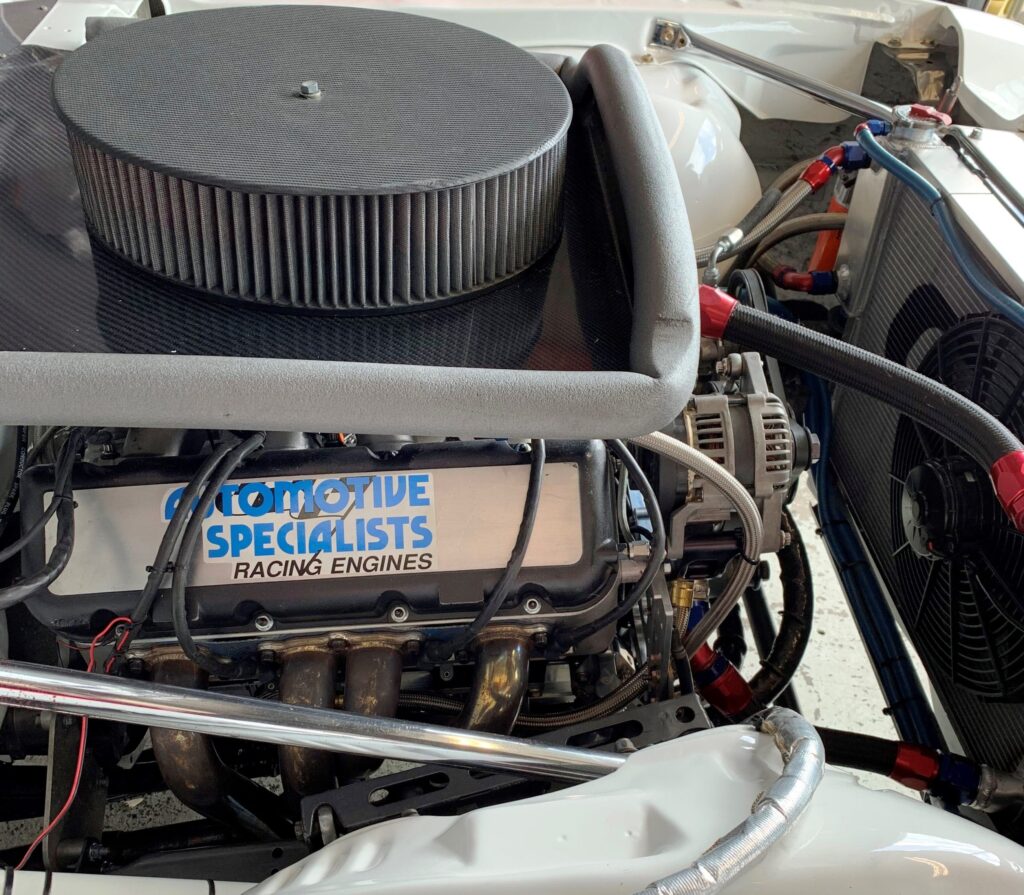
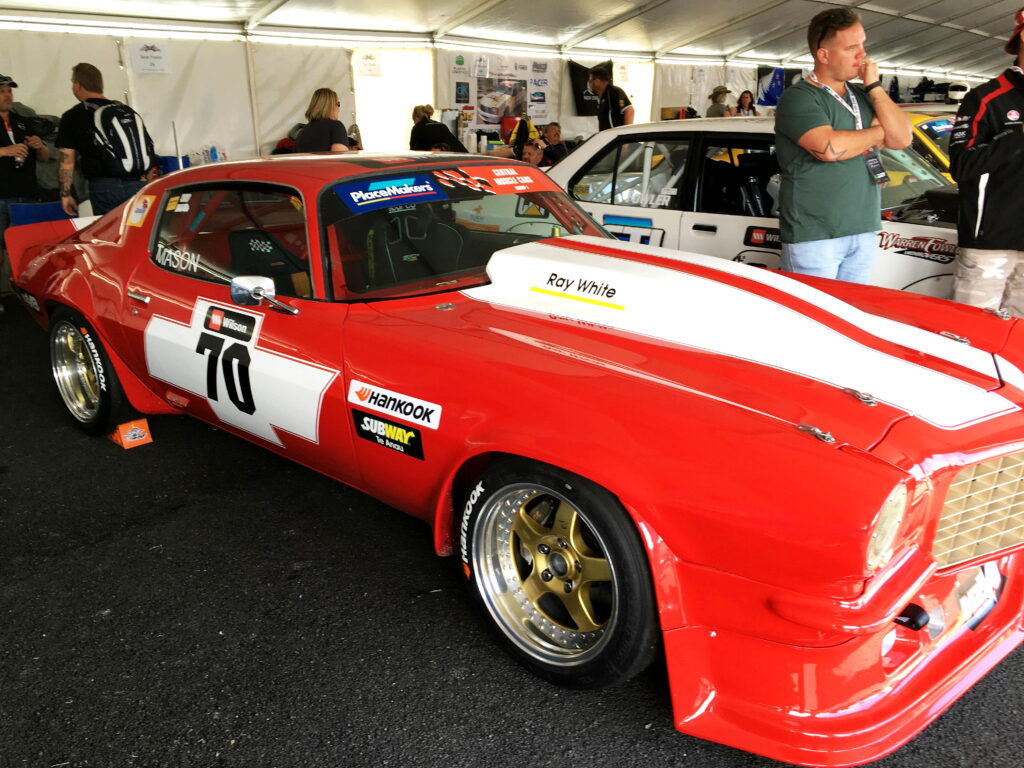
America’s Cup style
Brendan says everything on the car is adjustable and it’s much more of an up-spec car than Big Red.
“Everything is all new. It’s a Nascar engine of 410ci [6,716cc], running through a G-Force four-speed gearbox, and it runs a nine-inch Ford rear end with cambered rear-end hubs.
“It has the latest Brembo, six-pot callipers on the front. Grant [Dalton] said to Wayne, at the time when the America’s Cup was running, that if we win the America’s Cup then he could order those brakes. They were very expensive! Wayne made the phone call the moment they won the cup, so the new brakes came for the car!”
Managing the top-shelf mechanicals are some special electrics.
“It’s a really trick electrical system, and when the car was stripped Wayne rewired the whole car with aircraft wiring because it was lightweight. To rewire the car was $8500!”
Some America’s Cup experience can be seen in a light, carbon-fibre driveshaft. Special Italian alloy wheels also save weight.
“I have 10 of them and they were $1800 each. They are each 4kg lighter than a Simmons wheel. Grant was right into lightweight and the car is 260kgs lighter than Big Red. Grant just designs everything for light weight.”
The car is built to Central Muscle Car regulations but features a host of other technical additions to improve performance of both the car and driver, he explained.
“Everything is just so up-beat in the way everything has been done. It’s got an in-car camera system that came with the car which is real trick. One camera is inside and one outside. You can download everything at the track and it can tell your lap times, too. It has a lap-time computer, which you can get up easily on the dash. Grant doesn’t hold back!”
A big step up from Big Red, Brendan has been very happy with the development of the car so far.
“No, it’s a good car and it’s certainly nice to drive. I’m very pleased with it, and it’s just so much faster. Straight away out of the box at Teretonga, it was two-and-half-seconds faster around Teretonga straight away than Big Red, and five seconds a lap faster around Highland Park! I did a one-minute-eight-seconds at Teretonga, and it was still wheel spinning out of corners.”
A change was made to the rear springs, lightening them to get more traction before Highland Park.
“That’s probably why it went so fast!”
Hopefully motor racing can resume this coming season, once the current emergency is under control. The new car is a worthy replacement for Big Red.
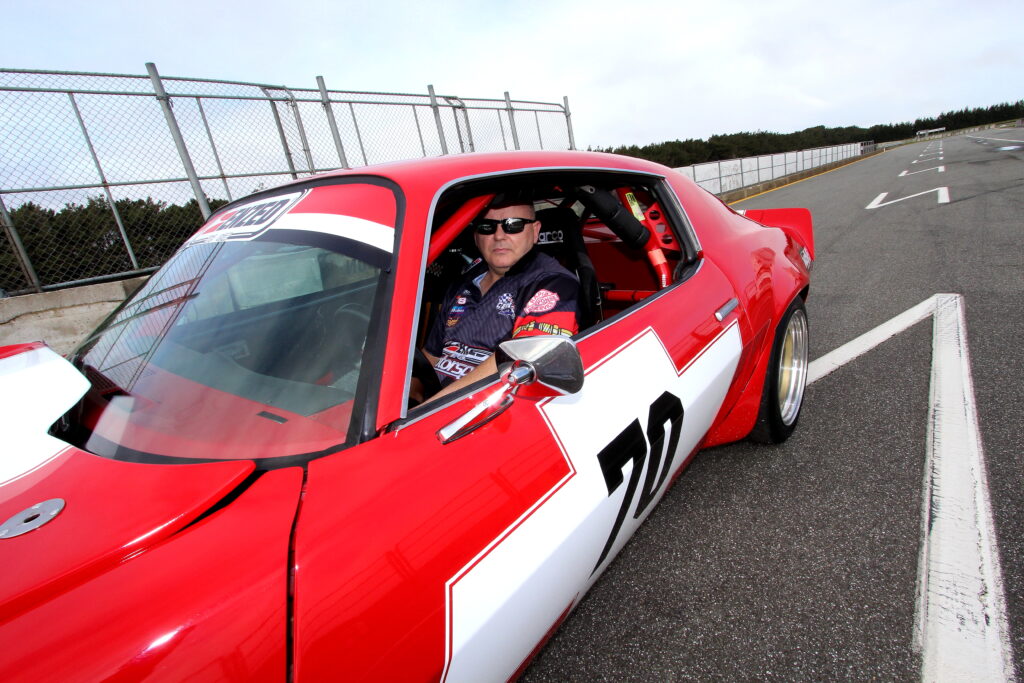
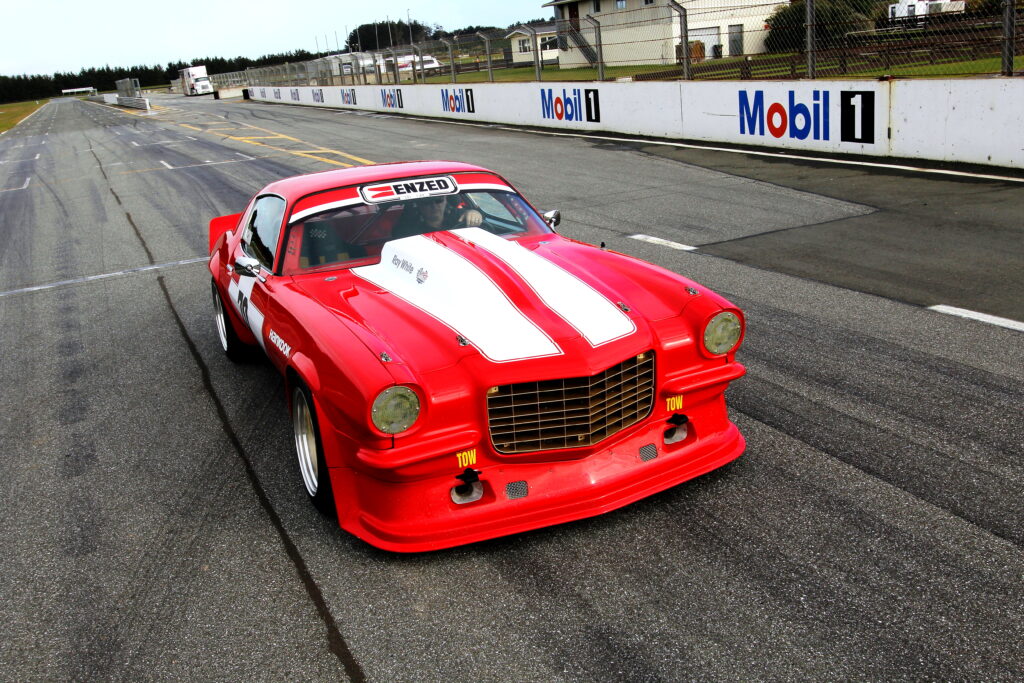
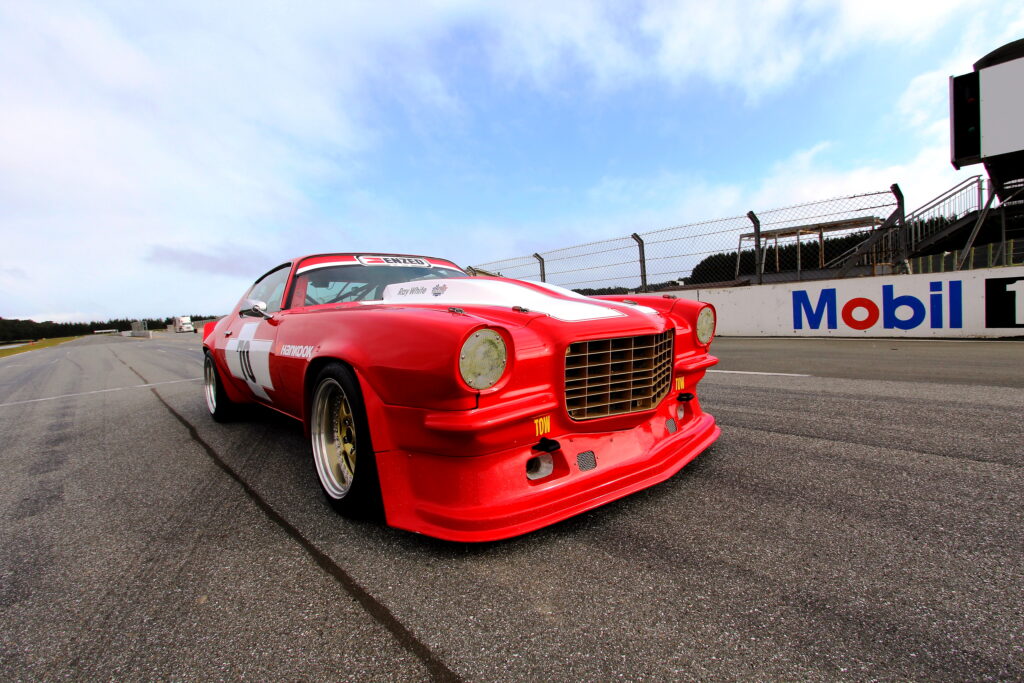
SPECIFICATIONS: BIG RED
1970 Chevrolet Camaro Coupe
Engine: 410ci small-block 2-2 Nascar-style custom Chevrolet, built by Phil Withington of USA – Kiwi Ltd, running a stroker crankshaft and JE Pistons through a Tilton clutch; Nascar heads and intake manifolds running a 930cfm Holly carburettor; MSD ignition
Driveline: Four-speed Jericho W4-4 gearbox
Differential: Detroit locker and floating axles
Suspension: Front, independent with coil-over shock absorbers; rear, leaf springs with Koni shock absorbers
Brakes: 330mm Brembo rotors with AP Nascar callipers on the front, with Wilwood rotors and callipers at the rear
Wheels & tyres: Front and rear, 17 x 11 Simmons three-piece alloy rims fitted with Hankook 275/40 X 17 tyres
Vehicle Exterior: Fibreglass bonnet, front guards, doors, and boot lid
Panel & Paint: Glasurit ‘Ducati Red’ by Bruce Colyer Auto Refinishers
Interior: Sparco race buckets, Momo steering wheel, AutoMeter gauges and roll cage by Ken ‘Hoppy’ Hopper
Performance: Horsepower: 835hp [623kw]
Lap times, Teretonga Park Raceway, Invercargill, 1m 01sec; Mike Pero Motorsport Park, Ruapuna, Christchurch, 1m 31sec; Highlands Motorsport Park, Cromwell, 1min 48sec
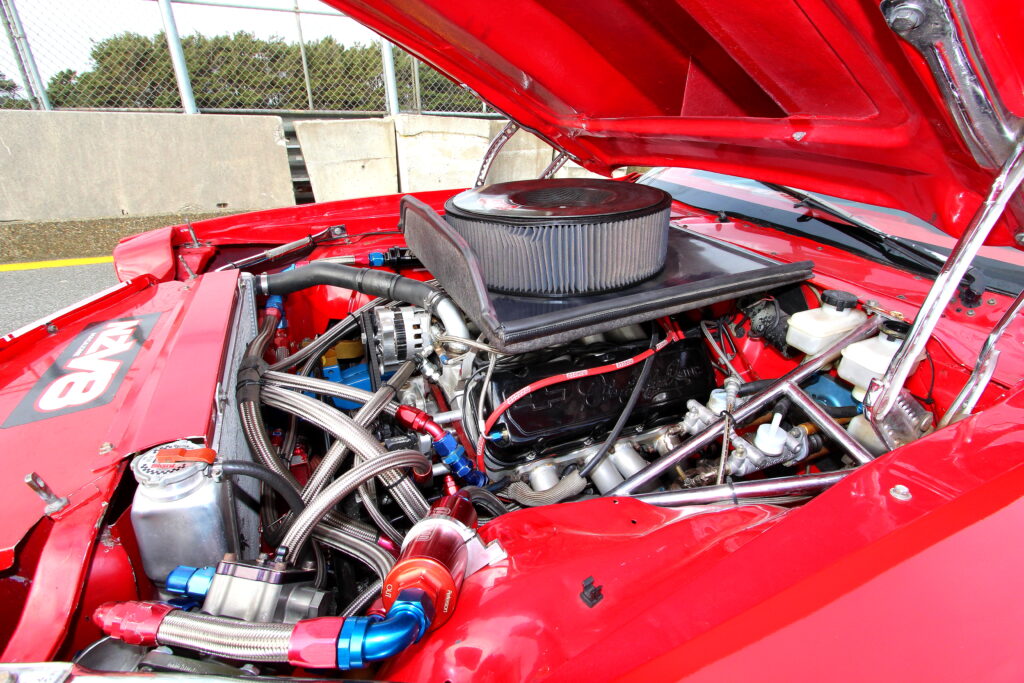
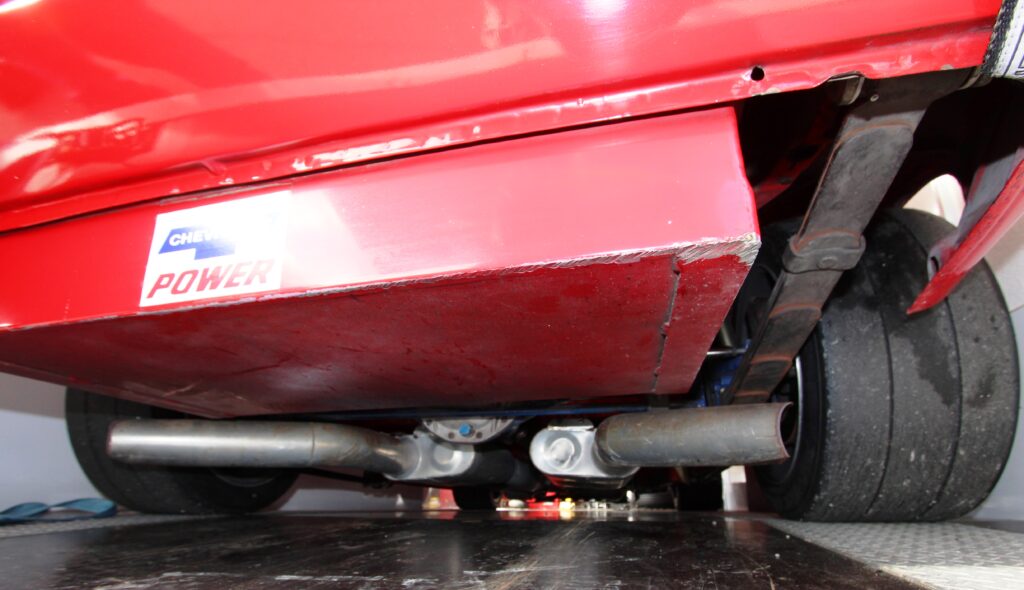
Wayne’s world
Former Pinepac Racing team driver Wayne Anderson remembers Big Red.
“At that stage, it was Pinepac Racing and Hoppy [Ken Hopper] was employed by us in our racing shed. Obviously, he was the number one mechanic and builder of the whole thing, and he was the initial builder of it. We decided on how we were going to build it. Back in those days, we built it for what was called ‘Intermarque Classics’.”
The team used to race Mustangs, and Big Red was the second generation Camaro they built, following the team’s dramatic departure from the Ford camp two years earlier in 1968.
“Because of the way the rules were, we were only allowed to use standard blocks and bits and pieces. I got really frustrated with Fords and said that was the last time I was running one of those things, so we are going to build a Camaro,” says Wayne.
The new chassis allowed them to get to grips with designing the cars for the track their way.
“The ’68 Camaro came from the car dealership, and later on we bought the ’70. We pulled it apart and built it.”
Wayne had recently seen Brendan’s Camaro and was pleased to see it looking much as he remembered it.
“It’s not far away from when we actually did build it, apart from the engine. We used fully aluminium Donovan engines in it and we had two engines. One was a 540ci and the other was a 460ci. They both looked identical, but one was a big block and it was sold with the 540 in it.” He sold the other engine separately.
“One of the best races was when I used to race against those Lighting Group Porches with Ray Williams and Owen Evans. In the rain, I remember at Pukekohe, we managed to beat them all! Back then, it had a bigger wing on the back like the old Falcon EA ones, and I had some side skirts on it. We used to run 17-inch Supercar slicks and Supercar wets. In the wet, it used to chuck a rooster tail 30- or 40-feet high.”
The aero kit was good for four-seconds a lap less at Pukekohe, he said.
Hoppy built the ’70 Camaro in 1997, and it last raced in a Supercar event in 2002–2003, he explained.
“It wasn’t far off the Supercars for pace. I enjoyed it a lot. It was quick in a straight line, obviously, but it didn’t have very good brakes. We only had Wilwood in those days, so it was not that flash.”
Other drivers found it a challenge to drive.
“I remember when Andy Booth used to drive for me, doing that NZV8 club back in 2002. He said it was all he wanted to do was go up and down the back straight at Puke’. ‘Man alive, it’s got some wick,’ Andy told me. It accelerated as hard in third gear as it did in top gear. It had about 700lb·ft of torque, but it only had about 700 horsepower. It didn’t have huge horsepower, but it had the cubic inches and it had the torque.”
“I raced it for a couple of seasons, and then Paul Kelly bought it off me, and then Brendan bought it.”
Wayne also knows Brendan Mason’s new car and says it will be a big step up.
“We’ve run it for Grant for the past four years. When Brendon drives that at Teretonga, he should be getting 59s with it once he gets used to it. It’s got more power, better suspension, better everything, all within the rules. When you see it, you will be quite impressed. It’s the new evolution.”


